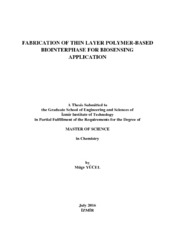Please use this identifier to cite or link to this item:
https://hdl.handle.net/11147/4847| Title: | Fabrication of thin layer polymer-based biointerphase for biosensing application | Other Titles: | Biyosensör uygulamaları için polimerik ince katmanlı biyoarayüz üretimi | Authors: | Yücel, Müge | Advisors: | Yıldız, Ümit Hakan | Keywords: | Volatile organic compounds Poly(vinylidene fluoride) Polymeric membranes Nanotubes Poly(methyl methacrylate) Biomarkers |
Publisher: | İzmir Institute of Technology Izmir Institute of Technology |
Source: | Yücel, M. (2016). Fabrication of thin layer polymer-based biointerphase for biosensing application. Unpublished master's thesis, İzmir Institute of Technology, İzmir, Turkey | Abstract: | This study aims to fabricate polymer-carbon nanotube composite as a bioelectronic interface for sensing volatile organic compounds (VOCs) in exhaled breath. Sensor platform is made of two layers i) polymeric membranes and ii) conducting layer. Poly(vinylidene fluoride) (PVDF), polystyrene (PS), and poly(methyl methacrylate) (PMMA) are selected as model polymers that are processed by electrospinning to utilize polymeric membranes. Multi-walled carbon nanotubes (MWCNTs) are used to fabricate conducting layer on top of PVDF, PS, PMMA polymer membranes. Aqueous solution of well-dispersed MWCNTs are obtained by several purification and filtration steps and conductivity of working MWCNT solution is adjusted about 120 μS/cm for whole study. This solution is further used to impregnate PVDF, PS, PMMA membrane. The PVDF-MWCNT, PS-MWCNT and PMMA-MWCNT sensor platforms are tested by electrochemical station that recording electrical resistivity change by time. All sensors platforms, made of three polymeric membranes-MWCNT, are found to be a responsive upon applying the toluene and acetone vapor. The sensing mechanism is hypothesized as the adsorption of VOCs onto the conducting CNT layer blocking electron stream on CNT network and causing resistivity change. The sensitivity of PVDF-MWCNT sensing platform is exceedingly higher with respect to other two candidates due to solvent vapor- polymeric membrane interactions. This contribution changes sensor platform characteristics and make them quite sensitive to trace amount of VOCs. Acetone and toluene are detected from ppm to ppb range and reproducible responses are recorded. As a result, acetone and toluene, biomarkers of diabetes and lung cancer, can be differentiated with produced sensor. Bu çalışma verilen nefesten uçucu organik bileşikleri algılamaya yönelik biyoelektronik arayüz olarak polimer-karbon nanotüp kompozitleri üretmeyi amaçlamaktadır. Sensor platform iki katmandan oluşmaktadır; i) polimerik zarlar ve ii) iletken katman. Polimerik zarları elektroeğirme metodu ile elde etmek için polivinilidin florür (PVDF), polistiren (PS) ve polimetil metakrilat (PMMA) seçilmiştir. PVDF, PS ve PMMA polimer zarlarının üst yüzeyindeki iletken katman çoklu katmanlı karbon nanotüp (MWCNT) ile sağlanmıştır. Solüsyon içerisinde iyi dağılan karbon nanotüpler birkaç saflaştırma ve filtreleme basamaklarıyla elde edilmiştir ve tüm çalışma için solüsyonun iletkenliği 120 μS/cm değerine ayarlanmıştır. Bu solüsyon daha sonra PVDF, PS ve PMMA zarlarının impregnasyonunda kullanılmıştır. PVDF-MWCNT, PS-MWCNT ve PMMA-MWCNT sensör platformları elektriksel direnç değişimini kaydeden bir elektrokimyasal istasyon ile test edilmiştir. Polimerik zar ve karbon nanotüpten elde edilmiş bütün sensör platformlarının uygulanan aseton ve toluen buharına cevap veren yapıda olduğu gözlemlenmiştir. Algılama mekanizmasının uçucu organik bileşiklerin iletken karbon nanotüp katmanı üzerine adsorpsiyonundan kaynaklandığı varsayılmaktadır böylelikle karbon nanotüp ağındaki elektron akışı engellenir ve direnç değişimi meydana gelir. Çözücü buharı – polimerik zar etkileşimi sebebiyle, PVDF-MWCNT algılayıcı platformunun hassaslığı diğer iki adayın hassaslığına göre oldukça fazladır. Bu katkı sensör platformunun karakteristiğini değiştirerek eser miktardaki uçucu organik bileşiklere hassas hale getirir. ppm ve ppb aralığındaki aseton ve toluen belirlenebilir ve tekrarlanabilir ve güvenilir cevaplar kaydedilir. Sonuç olarak, diyabet ve akciğer kanserinin biyobelirteci olan aseton ve toluen üretilen bu sensörler ile birbirlerinden ayrılabilir. |
Description: | Thesis (Master)--İzmir Institute of Technology, Chemistry, İzmir, 2016 Full text release delayed at author's request until 2019.08.11 Includes bibliographical references (leaves: 36-38) Text in English; Abstract: Turkish and English x, 38 leaves |
URI: | http://hdl.handle.net/11147/4847 |
| Appears in Collections: | Master Degree / Yüksek Lisans Tezleri |
Files in This Item:
| File | Description | Size | Format | |
|---|---|---|---|---|
| T001504.pdf | MasterThesis | 2.17 MB | Adobe PDF |  View/Open |
CORE Recommender
Page view(s)
146
checked on Apr 15, 2024
Download(s)
72
checked on Apr 15, 2024
Google ScholarTM
Check
Items in GCRIS Repository are protected by copyright, with all rights reserved, unless otherwise indicated.